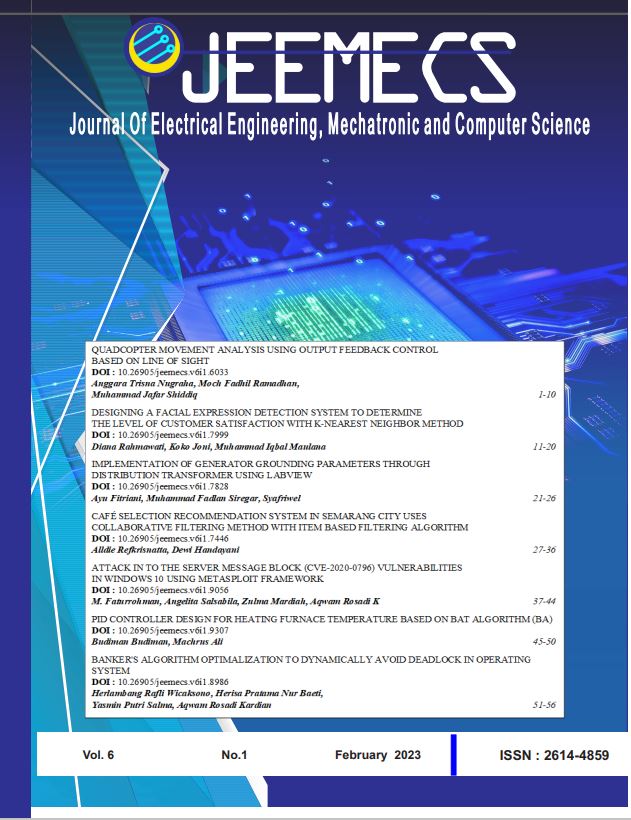PID Controller Design for Heating Furnace Temperature Based on Bat Algorithm (BA)
DOI:
https://doi.org/10.26905/jeemecs.v6i1.9307Keywords:
Bat Algorithm, Heating Furnace, PID Controller, Artificial IntelligenceAbstract
A furnace is a tool for heating materials, oil, and others. Furnaces use gas, coal, and oil as fuel. Temperature is the main parameter that needs to be controlled to remain stable, and precise and improve fuel efficiency. As technology develops, several methods can be used to control temperatures that are more reliable than conventional controls. The technology is a Proportional Integral Derivative (PID) controller. PID controllers have been proven and widely used in the industry, but determining the gain of the PID value is still not accurate. This can affect temperature stability, and slow response to reach the desired set point. Therefore, it is necessary to optimize the control system. Optimizing by looking for a better PID gain value with the artificial intelligence tuning method. The Artificial Intelligence method is Bat Algorithm(BA). The simulation results and discussion show that the best design is PID-BA with an overshoot of 0.0429, non undershoot, and the fastest settling time of 16.9 secondsDownloads
References
T. L. Mien, V. Van An, and B. T. Tam, “A Fuzzy-PID controller combined with PSO algorithm for the resistance furnace,†Adv. Sci. Technol. Eng. Syst., vol. 5, no. 3, pp. 568–575, 2020, doi: 10.25046/aj050371.
S. Wang, N. Li, and F. Yang, “Resistance furnace temperature system on fuzzy PID controller,†J. Inf. Comput. Sci., vol. 9, no. 9, pp. 2627–2634, 2012.
M. Al-Amin and M. S. Islam, “Design of an Intelligent Temperature Controller of Furnace System using the Fuzzy Self-tuning PID Controller,†in Proceedings of International Conference on Electronics, Communications and Information Technology, ICECIT 2021, 2021. doi: 10.1109/ICECIT54077.2021.9641467.
G. Chen, M. Li, and J. Zhang, “Application of fuzzy PID improved algorithm in thermogravimetric analysis of furnace temperature control,†Beijing Jiaotong Daxue Xuebao/Journal Beijing Jiaotong Univ., vol. 43, no. 5, pp. 94–101, 2019, doi: 10.11860/j.issn.1673-0291.20180158.
M. Ali, A. N. Afandi, A. Parwati, R. Hidayat, and C. Hasyim, “DESIGN OF WATER LEVEL CONTROL SYSTEMS USING PID AND ANFIS BASED ON FIREFLY ALGORITHM,†JEEMECS (Journal Electr. Eng. Mechatron. Comput. Sci., vol. 2, no. 1, Feb. 2019, doi: 10.26905/jeemecs.v2i1.2804.
Kadaryono, Rukslin, M. Ali, Askan, A. Parwanti, and I. Cahyono, “Comparison of LFC Optimization on Micro-hydro using PID, CES, and SMES based Firefly Algorithm,†in 2018 5th International Conference on Electrical Engineering, Computer Science and Informatics (EECSI), Oct. 2018, pp. 204–209. doi: 10.1109/EECSI.2018.8752733.
Muhlasin, Budiman, M. Ali, A. Parwanti, A. A. Firdaus, and Iswinarti, “Optimization of Water Level Control Systems Using ANFIS and Fuzzy-PID Model,†in 2020 Third International Conference on Vocational Education and Electrical Engineering (ICVEE), Oct. 2020, pp. 1–5. doi: 10.1109/ICVEE50212.2020.9243229.
M. Ali and M. Muhlasin, “Kontrol Kecepatan Putaran Permanent Magnet Synchronous Machine (PMSM) Menggunakan PID, FLC Dan ANFIS,†J. Elektro, vol. 4, no. 1, p. 253, Apr. 2019, doi: 10.30736/je.v4i1.302.
D. H. Kusuma, M. Ali, and N. Sutantra, “The comparison of optimization for active steering control on vehicle using PID controller based on artificial intelligence techniques,†in 2016 International Seminar on Application for Technology of Information and Communication (ISemantic), Aug. 2016, pp. 18–22. doi: 10.1109/ISEMANTIC.2016.7873803.
M. Ali et al., “The comparison of dual axis photovoltaic tracking system using artificial intelligence techniques,†IAES Int. J. Artif. Intell., vol. 10, no. 4, p. 901, Dec. 2021, doi: 10.11591/ijai.v10.i4.pp901-909.
Y. V. P. K. Y V Pavan Kumar, “Cascaded PID Controller Design for Heating Furnace Temperature Control,†IOSR J. Electron. Commun. Eng., vol. 5, no. 3, pp. 76–83, 2013, doi: 10.9790/2834-0537683.
M. Ali and M. Muhlasin, “Auto-Tuning Method for Designing Matlab DC Motor Speed Control With PID (Proportional Integral Derivative),†ADRI Int. J. Sci. Eng. Technol., vol. 1, no. 2, pp. 5–8, 2017, [Online]. Available: https://index.pkp.sfu.ca/index.php/record/view/856960
S. Zhao, S. Liu, R. De Keyser, and C. M. Ionescu, “The application of a new PID autotuning method for the steam/water loop in large scale ships,†Processes, vol. 8, no. 2, 2020, doi: 10.3390/pr8020196.
X. S. Yang, “Bat algorithm for multi-objective optimisation,†Int. J. Bio-Inspired Comput., vol. 3, no. 5, pp. 267–274, 2011, doi: 10.1504/IJBIC.2011.042259.
M. Ali, T. Fahmi, D. W. Khaidir, and H. Nurohmah, “Optimizing Single Axis Tracking for Bat Algorithm-based Solar Cell,†J. FESPE, vol. 2, no. 2, pp. 1–5, 2020.
Downloads
Published
Issue
Section
License
Our ethic statements are based on COPE’s Best Practice Guidelines for Journal Editors.
Publication decisions
The editor is responsible for deciding which of the articles submitted to the journal should be published.
The editor may be guided by the policies of the journal's editorial board and constrained by such legal requirements as shall then be in force regarding libel, copyright infringement and plagiarism. The editor may confer with other editors or reviewers in making this decision.
Fair play
An editor at any time evaluate manuscripts for their intellectual content without regard to race, gender, sexual orientation, religious belief, ethnic origin, citizenship, or political philosophy of the authors.
Confidentiality
The editor and any editorial staff must not disclose any information about a submitted manuscript to anyone other than the corresponding author, reviewers, potential reviewers, other editorial advisers, and the publisher, as appropriate.
Disclosure and conflicts of interest
Unpublished materials disclosed in a submitted manuscript must not be used in an editor's own research without the express written consent of the author.
Duties of Reviewers
Contribution to Editorial Decisions
Peer review assists the editor in making editorial decisions and through the editorial communications with the author may also assist the author in improving the paper.
Promptness
Any selected referee who feels unqualified to review the research reported in a manuscript or knows that its prompt review will be impossible should notify the editor and excuse himself from the review process.
Confidentiality
Any manuscripts received for review must be treated as confidential documents. They must not be shown to or discussed with others except as authorized by the editor.
Standards of Objectivity
Reviews should be conducted objectively. Personal criticism of the author is inappropriate. Referees should express their views clearly with supporting arguments.
Acknowledgement of Sources
Reviewers should identify relevant published work that has not been cited by the authors. Any statement that an observation, derivation, or argument had been previously reported should be accompanied by the relevant citation. A reviewer should also call to the editor's attention any substantial similarity or overlap between the manuscript under consideration and any other published paper of which they have personal knowledge.
Disclosure and Conflict of Interest
Privileged information or ideas obtained through peer review must be kept confidential and not used for personal advantage. Reviewers should not consider manuscripts in which they have conflicts of interest resulting from competitive, collaborative, or other relationships or connections with any of the authors, companies, or institutions connected to the papers.
Duties of Authors
Reporting standards
Authors of reports of original research should present an accurate account of the work performed as well as an objective discussion of its significance. Underlying data should be represented accurately in the paper. A paper should contain sufficient detail and references to permit others to replicate the work. Fraudulent or knowingly inaccurate statements constitute unethical behavior and are unacceptable.
Originality and Plagiarism
The authors should ensure that they have written entirely original works, and if the authors have used the work and/or words of others that this has been appropriately cited or quoted.
Multiple, Redundant or Concurrent Publication
An author should not in general publish manuscripts describing essentially the same research in more than one journal or primary publication. Submitting the same manuscript to more than one journal concurrently constitutes unethical publishing behaviour and is unacceptable.
Acknowledgement of Sources
Proper acknowledgment of the work of others must always be given. Authors should cite publications that have been influential in determining the nature of the reported work.
Authorship of the Paper
Authorship should be limited to those who have made a significant contribution to the conception, design, execution, or interpretation of the reported study. All those who have made significant contributions should be listed as co-authors. Where there are others who have participated in certain substantive aspects of the research project, they should be acknowledged or listed as contributors.
The corresponding author should ensure that all appropriate co-authors and no inappropriate co-authors are included on the paper, and that all co-authors have seen and approved the final version of the paper and have agreed to its submission for publication.
Disclosure and Conflicts of Interest
All authors should disclose in their manuscript any financial or other substantive conflict of interest that might be construed to influence the results or interpretation of their manuscript. All sources of financial support for the project should be disclosed.
Fundamental errors in published works
When an author discovers a significant error or inaccuracy in his/her own published work, it is the author’s obligation to promptly notify the journal editor or publisher and cooperate with the editor to retract or correct the paper.











